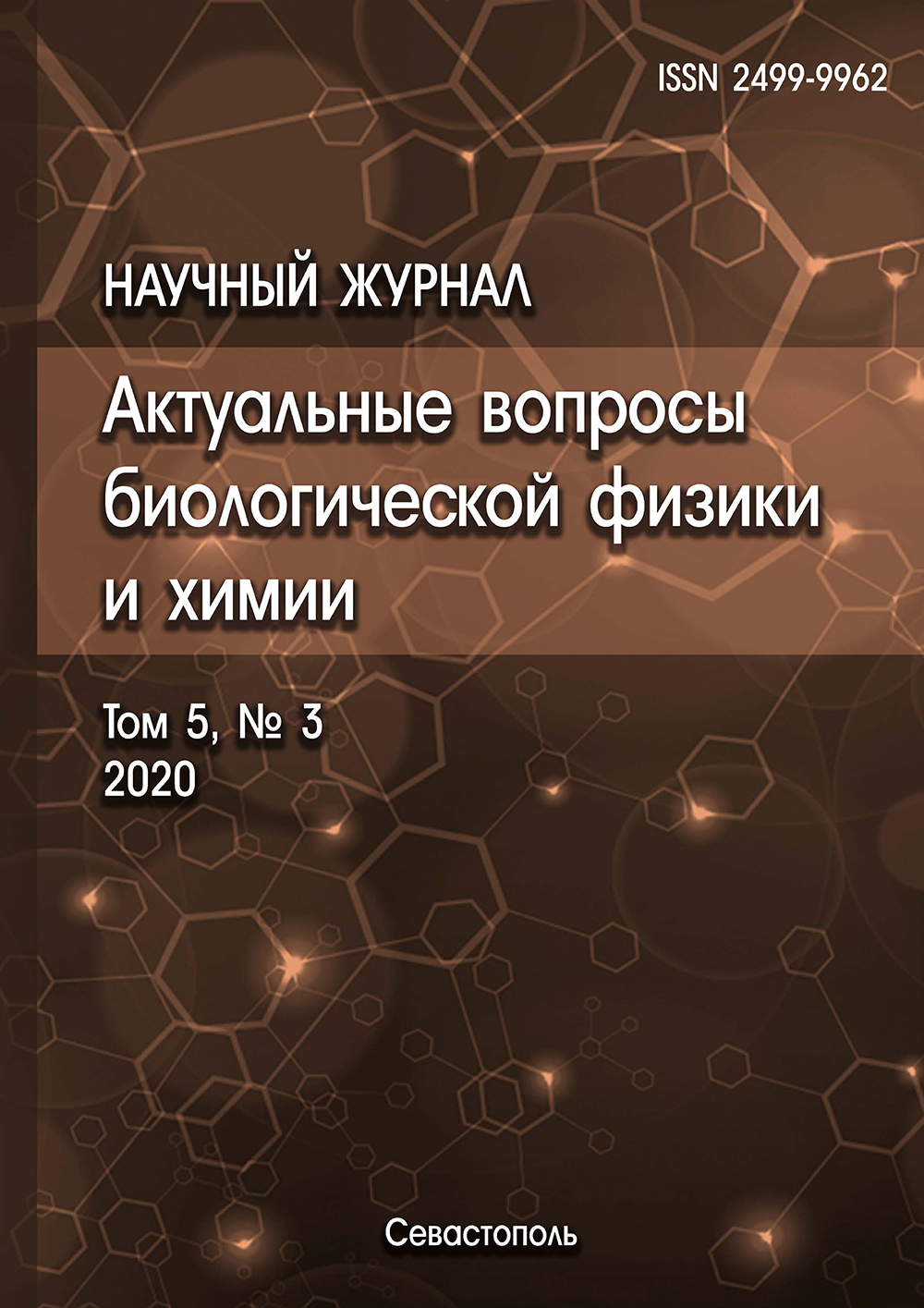The effect of various concentrations of nutrients on the growth dynamics of the microalgae Chlorella sorokiniana, as well as on the content of chlorophyll and the fluorescence of the cells of the culture is considered. Using the method of fluorimetry, the photosynthetic activity of culture cells was evaluated. It was shown that a low content of nitrates and phosphates leads to a decrease in the growth rate of the culture, a decrease in the concentration of chlorophyll in water samples, and also to a decrease in the speed of electron transport at the level of photosystem II, quantum yield, and basic fluorescence indices. The photosynthetic efficiency index (PI) of the functioning of photosystem II was evaluated. It was shown that the PI index increases with an intensive increase in the biomass of Chlorella sorokiniana, and decreases with a decrease in the growth rate of the culture.
fluorescence, phytoplankton, nitrates, phosphates, chlorophyll
1. Filenko O.F., Miheeva I.V Osnovy vodnoy toksikologii. M.: Kolos, 2007, 144 s.
2. Genty B., Briantais J.-M., Baker N.R. The relationship between the quantum yield of photosynthetic electron transport and quenching of chlorophyll fluorescence. Biochim. Biophys. Acta, 1989, vol. 990, pp. 87-92. DOI:https://doi.org/10.1016/S0304-4165(89)80016-9.
3. Strasser R.J., Srivastava A., Tsimilli-Michael M. The fluorescence transient as a tool to characterize and screen photosynthetic samples. In Probing Photosynthesis: Mechanism, Regulation & Adaptation. Ed. Mohanty, Yunus and Parthre. London: Taylor & Francis, 1998, pp.1-59.
4. Abakumov A.I., Pak S.Ya., Simonov A.Ya. Model' mineral'nogo pitaniya fitoplanktona. Vladivostok, 2011, 126 s.
5. Stepanova I.E., Bikbulatova E.M. Znachimost' sootnosheniy form biogennyh elementov dlya ocenki sovremennogo sostoyaniya Rybinskogo vodohranilischa. Povolzhskiy ekologicheskiy zhurnal, 2015, № 3, c. 330-337. EDN: https://elibrary.ru/VDWCAB
6. Smith V.H. The nitrogen and phosphorus dependence of algal biomass in lakes: an empirical and theoretical analysis. Limnol. Ocearnogr, 1982, vol. 23, pp. 1248-1255. DOI:https://doi.org/10.4319/lo.1982.27.6.1101.
7. Sharov A.N. Fitoplankton vodoemov Kol'skogo poluostrova. Petrozavodsk, 2004, 99 c. EDN: https://elibrary.ru/QKMQIH
8. Klochenko P.D., Medved' V.A., Vasil'chuk T.A., Vasilenko O.V. Osobennosti vliyaniya guminovyh kislot na razvitie planktonnyh vodorosley. Gidrobiologicheskiy zhurnal, 2010, t. 46, № 5, c. 102-110.
9. Suhodol'skaya I.L., Manturova O.V., Gryuk I.B. Fitoplankton malyh rek Rovenskoy oblasti (Ukraina) i svyaz' ego kolichestvennyh pokazateley s soderzhaniem biogennyh elementov. Gidrobiologicheskiy zhurnal, 2015, t. 51, № 3, c. 56-68.
10. Trifonova I.S., Raspletina G.F., Pavlova O.A. Organicheskoe veschestvo, biogennye elementy i fitoplankton v ocenke sostoyaniya rek basseyna Ladozhskogo ozera. Organicheskoe veschestvo i biogennye elementy vo vnutrennih vodoemah i morskih vodah. Materialy V Vserossiyskogo simpoziuma s mezhdunarodnym uchastiem. 10-14 sentyabrya 2012 g., g. Petrozavodsk, Respublika Kareliya, Rossiya. Petrozavodsk: Karel'skiy nauchnyy centr RAN, 2012, c. 66-70.
11. Bulgakov N.G., Levich A.P. Biogennye elementy v srede i fitoplankton: sootnoshenie azota i fosfora kak samostoyatel'nyy faktor regulyacii struktury al'gocenoza. Uspehi sovremennoy biologii, 1995, t. 115, vyp. 1, c. 13-23.
12. Filenko O.F. Metody biotestirovaniya kachestva vodnoy sredy. M.: Izd. MGU, 1989, 178 s.
13. Istvanovics V. Continuous monitoring of phytoplankton dynamics in Lake Balaton (Hungary) using on-line delayed fluorescence excitation spectroscopy // Freshwater Biology, 2005, no. 50, pp. 1950-1970. DOI:https://doi.org/10.1111/j.1365-2427.2005.01442.x.
14. Goldman C.R., Jassby A., Powell T. Interannual fluctuations in primary production: Meteorological forcing at two subalpine lakes. Limnol. Oceanogr, 1989, no. 34, pp. 310-323. DOI:https://doi.org/10.4319/lo.1989.34.2.0310.
15. Sterner R.W. Herbivores direct and indirect effects on algal populations. Science, 1986, no. 231, pp. 605-607. DOI:https://doi.org/10.1126/science.231.4738.605. EDN: https://elibrary.ru/IDVGKV
16. Goncharov A.V., Abdullaeva K.M. Osobennosti fitoplanktona Moskvoreckih vodohranilisch v svyazi s ih glubokovodnost'yu i izmeneniem urovnya vody. Uchenye zapiski Rossiyskogo gosudarstvennogo gidrometeorologicheskogo universiteta, 2014, № 34, s. 128-134. EDN: https://elibrary.ru/TQUAWR
17. Gol'cev V.N., Kaladzhi M.H., Kuzmanova M.A., Allahverdiev S.I. Peremennaya i zamedlennaya fluorescenciya hlorofilla a - teoreticheskie osnovy i prakticheskoe prilozhenie v issledovanii rasteniy. M. Izhevsk: Institut komp'yuternyh issledovaniy, 2014, 220 s.
18. Korneev D.Yu. Informacionnye vozmozhnosti metoda indukcii fluorescencii hlorofilla. K.: Al'terpres, 2002, 188 s.
19. Lysenko V.S., Varduni T.V., Soyer V.G., Krasnov V.P. Fluorescenciya hlorofilla rasteniy kak pokazatel' ekologicheskogo stressa: teoreticheskie osnovy primeneniya metoda. Fundamental'nye issledovaniya, 2013, № 4-1, c. 112-120. EDN: https://elibrary.ru/PUUHQB
20. Butler W.L. Chlorophyll fluorescence: a probe for electron transfer and energy transfer. In: Encyclopedia of Plant Physiology, ed. by Trebst A., Avron M. Springer. Berlin, 1977, vol. 5, pp. 149-167. DOI:https://doi.org/10.1146/annurev.pp. 42.060191.001525.










